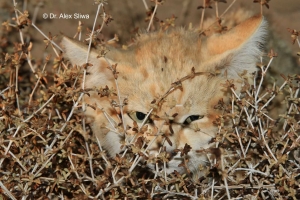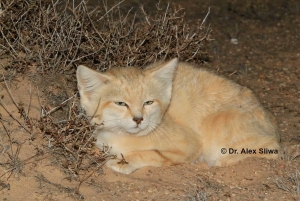This project is no longer active. July 2020
How do you save a small wild cat?
First you need to learn about their lives in the wild. You need to learn the ecology of the species – activity times and rest periods, the size of the home range and territory year round, the distances they cover every day, social and reproductive behaviours, their prey species and different hunting methods.
When that habitat is shared with other similar sized carnivores, you need to learn how the species co-exist.
Desert carnivores in Morocco
In 2013, Dr. Alex Sliwa and Gregory Breton made a self-financed trip to the Moroccan Sahara. They observed Sand Cats (Felis margarita), African Wildcats (Felis lybica), Fennec Foxes (Vulpes zerda) and Ruppell’s Foxes (Vulpes reppellii).
Never studied in Morocco, the distribution of the Sand Cat is still unclear. Between 1971 and 2000 only a few specimens had been observed in the wild. However, since 2005 and with a growing number of sightings in the Moroccan Sahara, an enduring presence of Sand Cats was confirmed.
Now they are undertaking the first-ever study on the ecology and behaviour of the Sand Cat in Morocco. While the Sand Cat is the priority species for research, they will also be studying the three other carnivores to determine how they all co-exist in their shared habitat.
How do you find a small wild cat in the desert?
Researchers actively search for them with a 4×4 truck, driving at low speed, at night, shining a 100W spot lamp in a sweeping motion to detect the eyeshine reflection. Once located, they net the animal which has taken refuge in the shrubs. When the cat has been sedated, they are measured and given a health check, then fitted with a radio collar. These animals will then be followed with an receiver and antenna to determine their movements.
Ongoing Sand Cat research
Once sufficient data is collected from radio-telemetry equipment and tracking collars then it is possible to:
 expand the study to the whole country to determine where the species are living in high, medium and low densities and where they are missing.
expand the study to the whole country to determine where the species are living in high, medium and low densities and where they are missing.- train students and/or local employees for field work, recording and tracking the collared Sand Cats, African Wildcats, and Foxes
- develop a partnership with local schools to speak in class and praise the animals to school children
- spread the results and knowledge learned during peer conferences, meetings and media events
